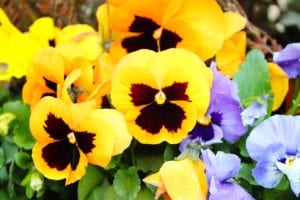Pansies have been a favorite cold-weather annual in San Antonio for a long time. So great is the love of pansies that sometimes, at the first cool breeze in early fall, San Antonio gardeners run out to buy pansies to switch out their pots and landscapes for the fall season, forgetting that October weather can turn on a dime and bring back 90 degree temps that will melt those pansies in a heartbeat.
November is time for San Antonio pansy lovers to rejoice! The consistently cooler temperatures are optimal for planting pansies without trepidation. Pansies will offer a big splash of color throughout the sometimes drab and dull San Antonio winter, and they will continue to produces spectacular blooms into spring until the temperatures become too warm. Pansies are a terrific, low-cost, winter annual that give you a great return on your investments with their long-blooming period. Let’s take a look at how to successfully incorporate them into your landscape.




5 Tips for Planting Pansies Successfully
1. Plant pansies at the right time of the year in San Antonio.
As mentioned above, fall and winter are the best time to plant pansies in our city. When nighttime temperatures have reached 60 degrees and have been consistent for some time, it’s time to plant pansies. Pansies can handle cold temperatures; even a hard freeze. They may look rough for a day or so, but a little sunshine will revive them and they’ll continue trucking along.
2. Plant pansies in masses for the most spectacular display.
Pots on a front porch spilling over with pansies create beautiful, seasonal décor. Pansies planted in mass in the front borders of annual beds fill in quickly and provide stunning eye-candy from the passerby on the street. We love both options of planting masses of the same color pansies, or choosing a mix of colors to create a wave of color.
3. Plant pansies in full sun to part sun in well-draining soil.
Pansies won’t bloom in the shade; offer them at least 6 hours of sunshine each day. Well-draining soil is a must for these cold-weather annuals. As with many annuals, soggy soils can result in rootrot and eventual death to your pansies. Many gardeners planting annuals in the ground decide to create raised beds filled with a mixture of peat moss and compost to help assist with poor drainage commonly found in our native soils. (Blend at least 3” of this organic matter into your garden soils.)
Choose a premium, lightweight potting soil (or add peat moss to a heavier potting soil) for pansies that will be planted in containers.
4. Don’t plant your pansies too deep.
Transplants of pansies should only be planted as deep as the top of the soil of their rootball. (Basically only as deep as the soil they are currently growing in inside their grower pots.) Planting annuals too deep also increases the onset of rootrot and death. Transplants of pansies should be spaced about 6-8 inches apart and set in the soil in a checkerboard pattern for maximum showiness and impact.
5. Maintain and protect your pansies.
The majority of pests you will find visiting your pansies are generally slugs, snails, and aphids. Aphids can be eradicated with diligent observation of your pansies and at the first sign of the pests, you can spray with a hard stream of water from the hose to dislodge the aphids. Safer insecticidal soap can also be used on aphids during early detection. Slugs and snails can be treated with baits like Sluggo Plus or Orthos Bug-Geta, sprinkled around the base of the plants.
Deadheading or occasional trimming of pansies that have gotten a little leggy will rejuvenate your plants and encourage pansies to bloom and retain their vigor.
Feed pansies every 3 weeks with a water soluble all purpose plant food to keep them blooming all season long.
Pansies can be placed pretty much any sunny location in your landscape. They make perfect container specimens in pots or window boxes, and are just as lovely in garden beds, edgings, rock gardens, and wall gardens. They look adorable as a cut flower in tiny, glass vases, bringing cheerful, vibrant, color into your homes during winter. Come scoop up an armful of these fabulous annuals to brighten up your world this season!
~ The Happy Gardener, Lisa Mulroy


Good informations thank you Pansies are fun I am going to put them in boarder
Hi Mary!
I bet they are going to look fabulous there. Remember that pansies are annuals that love to be fed. Offer them diluted soluble fertilizer at planting and then a regular dose every 3-4 weeks. You can also cut back pansies as they grow if they begin to look leggy. You’ll get a fresh flush of new blooms. Happy planting!